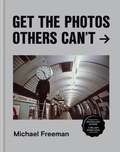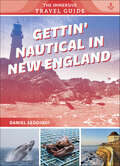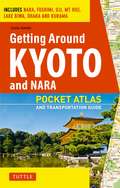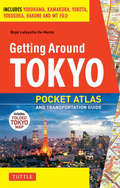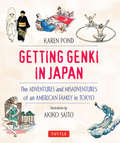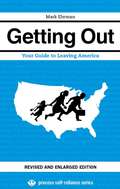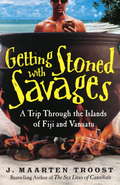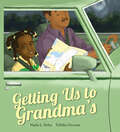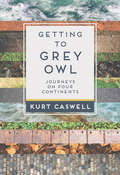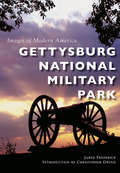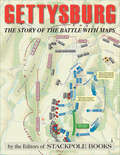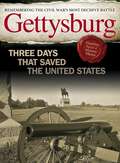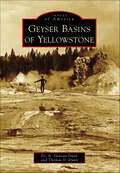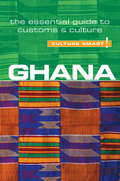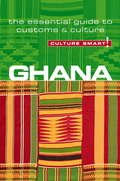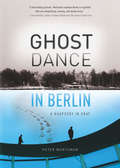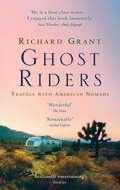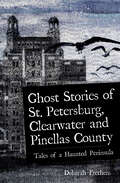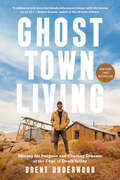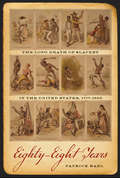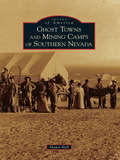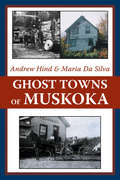- Table View
- List View
Get the Photos Others Can't
by Michael FreemanGetting the best possible photo is not a game of chance - there are proven methods and innovative approaches that the professional photographer uses to succeed. From Freeman's decades of reportage experience, he has developed proven methods for going beyond where tourists stop, and delivering the photographs that make the cover. Get the Photos Others Can't uses five 'nodes' or guiding principles, in various combinations, to elucidate each particular method of access: Right Place, Right Time - train yourself in the art of anticipationHearts & Minds - understand the importance of people skillsImmersion - involve yourself fully in your subjectDeep Learning - research and reflect Left Field - take an unexpected direction to find a new angle.With examples from Freeman's own archive of images, as well as from iconic photographers including Weegee, Cindy Sherman, Guy Bourdin, W. Eugene Smith and Garry Winogrand, the secrets shared in this book will let you find your own modus operandi for overcoming the obstacles between you and the shot, so you can bring home your own world-class images.
Get the Photos Others Can't
by Michael FreemanGetting the best possible photo is not a game of chance - there are proven methods and innovative approaches that the professional photographer uses to succeed. From Freeman's decades of reportage experience, he has developed proven methods for going beyond where tourists stop, and delivering the photographs that make the cover. Get the Photos Others Can't uses five 'nodes' or guiding principles, in various combinations, to elucidate each particular method of access: Right Place, Right Time - train yourself in the art of anticipationHearts & Minds - understand the importance of people skillsImmersion - involve yourself fully in your subjectDeep Learning - research and reflect Left Field - take an unexpected direction to find a new angle.With examples from Freeman's own archive of images, as well as from iconic photographers including Weegee, Cindy Sherman, Guy Bourdin, W. Eugene Smith and Garry Winogrand, the secrets shared in this book will let you find your own modus operandi for overcoming the obstacles between you and the shot, so you can bring home your own world-class images.
Gettin' Nautical in New England
by Daniel SeddiquiIn the latest edition of the Immersive Travel Guide series, Seddiqui explores how the waters of the Atlantic Ocean have indelibly marked New England. Focusing on the region's nautical past and present, Seddiqui presents an experience-based travel journey with stops in Wells and Portland in Maine; Portsmouth, New Hampshire; Gloucester, Boston, Plymouth, Hyannis and Provincetown, Nantucket, Martha&’s Vineyard, and Wareham in Massachusetts; Newport, Rhode Island; and Mystic and Greenwich in Connecticut. The itinerary includes • fun activities, from fishing excursions to lessons in sailing and rowing; • hands-on opportunities to learn skills such as ship repair and how to cook lobster and clam chowder; and • up-close guidance from skilled makers of nautical-themed art and crafts such as Nantucket baskets, sea glass and scrimshaw art, and knotwork; plus • interviews with locals and information on lodging and other attractions to check out along the way. Get ready, get set, get nautical in New England!
Getting Around Kyoto
by Colin SmithThis Kyoto and Nara travel guide contains everything you need for getting around the region including a pull-out atlas! Kyoto is the number one travel destination for foreigners in Japan, but it can be a difficult place to navigate if you don't know Japanese. This handy new pocket atlas and transportation guide is an indispensable tool to help non-Japanese visitors find their way around the city. Dedicated journalist and urban explorer Colin Smith has devoted many years to exploring Japan on foot and by various forms of public transportation. Getting Around Kyoto and Nara is conveniently divided into chapters showing the user how to get to Kyoto by air or train, how to get into the city, and how to get around Kyoto and into the surrounding countryside using public transport. It includes chapters for Nara, Uji, Fushimi, Otsu, Ohara, Mt. Hiei, Kurama and other popular tourist areas around Kyoto. Detailed maps are given for each district of Kyoto showing the precise locations of temples, shrines, gardens, museums, hotels, shopping districts, restaurants, parks and other landmarks. Smith gives the reader detailed information on how to take a subway, a train or a bus around the city, how to read the signs, and how to operate the Japanese ticket machines to buy a ticket. He provides route diagrams showing all the stops along each route so users know where to get on and off. Getting Around Kyoto and Nara includes: A large fold-out map of Kyoto Detailed area inset maps Train and subway routes Bus routes and bus stops near all the sights Other means of transport, like renting a bicycle and taking a taxi This guide is packed with practical and useful information on the Kyoto region's lodgings, restaurants, and the best places to visit-including all of the region's famous temples, shrines, parks and historical monuments.
Getting Around Tokyo Pocket Atlas and Transportation Guide: Includes Yokohama, Kamakura, Yokota, Yokosuka, Hakone and MT Fuji
by Boye Lafayette De MenteThis pocket atlas and Japan travel guide is an indispensable tool for getting around Tokyo-whether as a first-time visitor, or a local resident.<P><P>The travel book is conveniently divided into chapters that enable the user to know what to do on arriving at Narita or Haneda Airport, and then how to get into and around the city using all available means of public transport. Area maps for all the key districts of Tokyo show the locations of hotels, shopping centers, office buildings, temples, shrines, embassies and restaurants as well as their proximity to the nearest subway and JR stations. Information on bus routes and private railways is also given, with detailed diagrams for each route, thus enabling the user to have several options for getting around. Places of interest outside Tokyo are also covered: Hakone, Yokohama, Kamakura, Yokosuka, Mt Fuji and Tokyo Disneyland. Numerous area maps (including maps for Yokota, Atsugi and Zama) and diagrams for bus routes and private railways facilitate journeys to all of these destinations.This Tokyo travel guide contains: Arriving in Tokyo Maps of Tokyo Navigating the Tokyo's Railway & Subway & Maze Buses Routes Getting Around Yokohama, Kawasaki, Hakone & Kamakura Useful Vocabulary and Expressions
Getting Genki in Japan
by Karen Pond Akiko SaitoThe unexpected gift of a favored bottle of shiraz from her husband leads to the adventure of a lifetime for Karen Pond and her family--moving from rural Maine to the largest city in the world: Tokyo, Japan.Getting Genki in Japan is a collection of illustrated essays and musings of a Down East Mom's absurd and exhilarating adventures in the Far East. From bewildered and befuddled (and back again) to (somewhat) wise, these narratives recount a journey of cultural discoveries, experiences and the follies of a newcomer to Japan; including (mis)identifying food, (mis)pronouncing Japanese, (mis)pantomiming for necessities, and finally figuring out how to flush the Japanese toilet!
Getting Genki in Japan
by Karen Pond Akiko SaitoThe unexpected gift of a favored bottle of shiraz from her husband leads to the adventure of a lifetime for Karen Pond and her family--moving from rural Maine to the largest city in the world: Tokyo, Japan.Getting Genki in Japan is a collection of illustrated essays and musings of a Down East Mom's absurd and exhilarating adventures in the Far East. From bewildered and befuddled (and back again) to (somewhat) wise, these narratives recount a journey of cultural discoveries, experiences and the follies of a newcomer to Japan; including (mis)identifying food, (mis)pronouncing Japanese, (mis)pantomiming for necessities, and finally figuring out how to flush the Japanese toilet!
Getting Out
by Cletus Nelson Mark EhrmanOne of the most popular titles in Process' Self-Reliance series, Getting Out is a smartly designed and easy-to-navigate compendium about your best options for a new homeland, and how to navigate a myriad of hurdles before and after you get there. Here are the rules, resources, and experiences of dozens of expat Americans on every continent, including author Mark Ehrman, who moved from Los Angeles to Berlin after publishing Getting Out. The updated and expanded edition contains new information on taxes, healthcare, food, drink, drugs, security, and suggestions about how to start a business or make a living in foreign lands.
Getting Stoned with Savages: A Trip Through the Islands of Fiji and Vanuatu
by J. Maarten TroostWith The Sex Lives of Cannibals, Maarten Troost established himself as one of the most engaging and original travel writers around. Getting Stoned with Savages again reveals his wry wit and infectious joy of discovery in a side-splittingly funny account of life in the farthest reaches of the world. After two grueling years on the island of Tarawa, battling feral dogs, machete-wielding neighbors, and a lack of beer on a daily basis, Maarten Troost was in no hurry to return to the South Pacific. But as time went on, he realized he felt remarkably out of place among the trappings of twenty-first-century America. When he found himself holding down a job--one that might possibly lead to a career--he knew it was time for him and his wife, Sylvia, to repack their bags and set off for parts unknown. Getting Stoned with Savages tells the hilarious story of Troost's time on Vanuatu--a rugged cluster of islands where the natives gorge themselves on kava and are still known to "eat the man." Falling into one amusing misadventure after another, Troost struggles against typhoons, earthquakes, and giant centipedes and soon finds himself swept up in the laid-back, clothing-optional lifestyle of the islanders. When Sylvia gets pregnant, they decamp for slightly-more-civilized Fiji, a fallen paradise where the local chiefs can be found watching rugby in the house next door. And as they contend with new parenthood in a country rife with prostitutes and government coups, their son begins to take quite naturally to island living--in complete contrast to his dad.
Getting Us to Grandma’s
by Nadia L. HohnNo one knows maps like Nikki — but can she get her family to Grandma's house in time? Nikki’s family is preparing for a long road trip from Toronto to the Bronx to attend Uncle Travis's wedding. They pack their suitcases, boxes of Jamaican black cake, and most importantly to Nikki, the big map book! Nikki loves geography and enjoys tracing the routes to all the places her relatives live — her Grandpa in Florida, her cousins in Atlanta, DC, and Boston. She daydreams of England, where other family lives, and Jamaica and Africa, where her roots run deep. Her attention comes back to the road trip when it’s clear that Daddy’s taken a wrong turn. “I can help!” says Nikki, who proves to be an excellent navigator. She guides them back to the Bronx Expressway, under the elevated subway tracks, onto a street of brown row houses and safely to Grandma’s. Inspired by the childhoods of author Nadia L. Hohn and illustrator TeMika Grooms, Getting Us to Grandma’s is full of fun historic details — a world before Google Maps! — and authentic cultural moments shared by diasporic families, whose stories can be traced across continents. A fantastic representation of Black girls in STEM. Key Text Features Illustrations Correlates to the Common Core State Standards in English Language Arts: CCSS.ELA-LITERACY.RL.K.6 With prompting and support, name the author and illustrator of a story and define the role of each in telling the story. CCSS.ELA-LITERACY.RL.1.3 Describe characters, settings, and major events in a story, using key details. CCSS.ELA-LITERACY.RL.1.7 Use illustrations and details in a story to describe its characters, setting, or events.
Getting to Grey Owl
by Kurt CaswellWriter, teacher, and adventurer Kurt Caswell has spent his adult life canoeing, hiking, and pedaling his way toward a deeper understanding of our vast and varied world. Getting to Grey Owl: A Man's Journey across Four Continents chronicles over twenty years of Caswell's travels as he buys a rug in Morocco, rides a riverboat in China, attends a bullfight in Spain, climbs four mountains in the United Kingdom, and backpacks a challenging route through Iceland's wild Hornstrandir Peninsula. Writing in the tradition of such visionary nomads as Hermann Hesse, Robert Louis Stevenson, Bruce Chatwin, Paul Theroux, Pico Iyer, Samuel Taylor Coleridge, and William Wordsworth, Caswell travels through wild and urban landscapes, as well as philosophical and ideological vistas, championing the pleasures of a wandering life. Far from the trappings of the everyday, he explores a range of ideas: the meaning of roads and pathways, the story of Cain and Abel, nomadic life and the evolution of the human animal, the role of agriculture in the making of the modern world, and the fragility of love.
Gettysburg National Military Park (Images of Modern America)
by Jared Frederick Christopher GwinnThe picturesque Gettysburg Battlefield has long been memorialized as an iconic landscape of America's national identity. The tumultuous Civil War battle and Abraham Lincoln's subsequent address transformed the country in profound ways that continue to echo throughout the ages. In the aftermath of the struggle, Gettysburg National Military Park was embraced by citizens not only as a shrine of commemoration but also as a public space utilized for leisure, education, politics, and discovery. This compelling photographic history documents the park from the post-World War II era onward, chronicling the dramatic evolutions the battlefield has undergone in the wake of modern tourism. Exploring the fascinating issues of historical memory, preservation, and popular culture, the book paints a vivid picture of a national park at work for the benefit "of the people."
Gettysburg: The Story of the Battle with Maps
by Editors of Stackpole BooksA unique visual account: &“The hour-by-hour maps of the maneuvering and fighting provide the clearest cartographic picture of the battle in existence.&” —James M. McPherson, Pulitzer Prize-winning author of Battle Cry of Freedom In this extraordinary book, seventy crystal-clear color maps and insightful text tell the hour-by-hour story of the three-day Battle of Gettysburg. Each map shows the same three-and-a-half-by-four-and-a-half-mile view of the battlefield, allowing the reader to visualize the battle as it developed over the entire area, including key engagements, troop movements and positions, and locations of commanders. It sheds new light on important events such as the first clash west of town on July 1, the fighting for Cemetery Hill, the defense of Little Round Top, Pickett&’s Charge, and more. &“The accompanying text brings the battle alive and nicely compliments the maps.&” —D. Scott Hartwig, author of To Antietam Creek &“The movements are depicted clearly, and in full color, so that even a complete newcomer to the battle can follow the action easily.&”—Craig L. Symonds, author of The American Heritage History of the Battle of Gettysburg
Gettysburg: Three Days That Saved the United States
by Ben NussbaumPacked with facts, stories, and illustrations, a guide to the historic Pennsylvania battle that marked a turning point in the American Civil War. From the first shots fired at 7:30 a.m. on July 1, 1863 in a field west of Gettysburg to Robert E. Lee&’s losing gamble known as Pickett&’s Charge on July 3, just fifty-five hours later, Gettysburg is a snapshot of three of the most important days in US history. Editor Ben Nussbaum has compiled a fascinating retelling of political, military, and social conditions that thrust the sleepy town of Gettysburg forever into the pages of history books. In addition to informative timelines and fact sheets of the battle of Gettysburg and the Civil War, this handsomely illustrated volume also captures the human stories—of Father Corby and the Irish Brigade; Amos Humiston, the unidentified father who died in battle clutching a photograph of his three children; the eleven-year-old sergeant, John L. Clem, who killed a Confederate soldier; John Burns, the only civilian to fight in the battle; and Jubal Early, an unlikely general who &“scared Abraham Lincoln like hell.&” Also included is the poignant story and photographs of a reunion fifty years later of fifty thousand Union and Confederate veterans, among them a man believed to be 112 years old, and a chapter focusing on a dozen significant monuments among Gettysburg&’s numerous historic landmarks. In addition, a resource section offers readers and visitors ways to learn more about the Battle of Gettysburg, including books, websites, and games.
Geyser Basins of Yellowstone
by Thomas D. Dunn N. Genean DunnYellowstone National Park contains over half the world�s active geysers, with more than 700 within its 3,472 square miles. The most famous geyser is Old Faithful, named in 1870 during the Washburn-Langford-Doane Expedition. In 1871, the US Geological and Geographical Survey, led by Dr. F.V. Hayden, reached the Upper Geyser Basin. In just over a day, the explorers witnessed eruptions of many geysers still seen today, including Giantess, Beehive, Grotto, Castle, and Old Faithful. Yellowstone became the first National Park in 1872. Since then, visitors have come in increasing numbers to witness the unique geysers, numerous wildlife, and spectacular scenery.
Ghana - Culture Smart!
by Ian UtleyThe "Gateway to Africa," Ghana welcomes around a million tourists, aid workers, and business travelers a year--visitors who invariably come away with glowing reports of a fertile land, tropical scenic beauty, rich culture and traditions, and many first-rate tourist attractions. It is, however, the Ghanaians themselves who make the biggest impression. It is through their hospitality and love of peace that Ghana has a claim to be the safest and friendliest country in Africa. Ghanaians are welcoming to foreign guests, respectful to each other, strong followers of tradition, and have deep familial and communal values. For most visitors, Ghana comes as a wonderfully refreshing change, with valuable lessons to teach the outside world. Ghanaians like to do things their own way, and Ghana is a proud country that does not cater exclusively to tourists but rather expects them to fit in with the Ghanaian pace and way of life. Thus a visit to Ghana is not without its downsides, and visitors can experience frustrations and barriers. This revised and updated edition of Culture Smart! Ghana explains the complexities and nuances of Ghanaian society with clarity and humor. Visitors are expected to be sympathetic to their customs and beliefs, and their hosts will have no hesitation in saying, "We don't do that here," should a faux pas be made or a taboo broken. It is important to Ghanaians that they, and their guests, follow certain rules and codes of conduct. Culture Smart! Ghana describes these rules, explains where they come from, helps to disperse the frustrations and barriers, and offers the reader an opportunity to enjoy more fully all that this beautiful country has to offer.
Ghana - Culture Smart!
by Ian UtlleyCulture Smart! provides essential information on attitudes, beliefs and behavior in different countries, ensuring that you arrive at your destination aware of basic manners, common courtesies, and sensitive issues. These concise guides tell you what to expect, how to behave, and how to establish a rapport with your hosts. This inside knowledge will enable you to steer clear of embarrassing gaffes and mistakes, feel confident in unfamiliar situations, and develop trust, friendships, and successful business relationships.Culture Smart! offers illuminating insights into the culture and society of a particular country. It will help you to turn your visit-whether on business or for pleasure-into a memorable and enriching experience. Contents include* customs, values, and traditions* historical, religious, and political background* life at home* leisure, social, and cultural life* eating and drinking* dos, don'ts, and taboos* business practices* communication, spoken and unspoken"Culture Smart has come to the rescue of hapless travellers." Sunday Times Travel"... the perfect introduction to the weird, wonderful and downright odd quirks and customs of various countries." Global Travel"...full of fascinating-as well as common-sense-tips to help you avoid embarrassing faux pas." Observer"...as useful as they are entertaining." Easyjet Magazine"...offer glimpses into the psyche of a faraway world." New York Times
Ghost Dance in Berlin
by Peter WortsmanEvery great city is a restless work in progress, but nowhere is the urban impulse more in flux than in Berlin, that sprawling metropolis located on the fault line of history. A short-lived fever-dream of modernity in the Roaring Twenties, redubbed Germania and primped up into the megalomaniac fantasy of a Thousand-Year Reichstadt in the Thirties, reduced in 1945 to a divided rubble heap, subsequently revived in a schizoid state of post-World War II duality, and reunited in 1989 when the wall came tumbling down - Berlin has since been reborn yet again as the hipster hub of the 21st century. This book is a hopscotch tour in time and space.Part memoir, part travelogue, Ghost Dance in Berlin is an unlikely declaration of love, as much to a place as to a state of mind, by the American-born son of German-speaking Jewish refugees. Peter Wortsman imagines the parallel celebratory haunting of two sets of ghosts, those of the exiled erstwhile owners, a Jewish banker and his family, and those of the Führer's Minister of Finance and his entourage, who took over title, while in another villa across the lake another gaggle of ghosts is busy planning the Final Solution.
Ghost Riders: Travels with American Nomads
by Richard GrantRichard Grant has never spent more than twenty-two consecutive nights under the same roof. Motivated partly by his own wanderlust and partly by his realisation that America is a land populated by wanderers, he set out to test his theory. AMERICAN NOMADS is the extraordinary result. 'Freedom is impossible and meaningless within the confines of sedentary society, the only true freedom is the freedom to cross the land, beholden to no one'. Grant follows the trails of the first European to wander across the American West (a failed conquistador); joins a group of rodeo-competing cowboys (and gets thrown by a mechanical bull); tells the story of the vanishing nomadic Indians and links up with 300,000 'gerito gypsies' - old people who live and travel in their RVs (Recreational Vehicles).'When all is said and done, there are two types of men: those who stay at home and those who do not' Kipling. This is the story of those that 'did not' who are populated - and are still travelling - in America.
Ghost Riders: Travels with American Nomads
by Richard GrantRichard Grant has never spent more than twenty-two consecutive nights under the same roof. Motivated partly by his own wanderlust and partly by his realisation that America is a land populated by wanderers, he set out to test his theory. AMERICAN NOMADS is the extraordinary result. 'Freedom is impossible and meaningless within the confines of sedentary society, the only true freedom is the freedom to cross the land, beholden to no one'. Grant follows the trails of the first European to wander across the American West (a failed conquistador); joins a group of rodeo-competing cowboys (and gets thrown by a mechanical bull); tells the story of the vanishing nomadic Indians and links up with 300,000 'gerito gypsies' - old people who live and travel in their RVs (Recreational Vehicles).'When all is said and done, there are two types of men: those who stay at home and those who do not' Kipling. This is the story of those that 'did not' who are populated - and are still travelling - in America.
Ghost Stories of St. Petersburg, Clearwater and Pinellas County: Tales from a Haunted Peninsula (Haunted America Ser.)
by Deborah FrethemSome parts of sunny Florida can be downright chilling . . . A haunting historical tour with photos included! Does the restless ghost of a murder victim haunt a Gulfport home? Does a doomed pirate search for his lost treasure at John&’s Pass? Are sea captains and Civil War soldiers still combing the area, years after their deaths? With wit and style, the &“Queen of Haunts,&” Deborah Frethem, calls upon years of experience as the general manager and guide of Tampa Bay Ghost Tours to present legends of sinister deeds and whispers of the past from Florida&’s haunted peninsula.
Ghost Town Living: Mining for Purpose and Chasing Dreams at the Edge of Death Valley
by Brent UnderwoodNEW YORK TIMES BESTSELLER • A long-abandoned silver mine for sale sounded like an adventure too great to pass up, but it turned into much more—a calling, a community of millions, and hard-earned lessons about chasing impractical dreams.&“Inspiring and meditative—the story of man vs nature and man vs himself.&”—Ryan Holiday, #1 New York Times bestselling author of The Obstacle is the WayThe siren song of Cerro Gordo, a desolate ghost town perched high above Death Valley, has seduced thousands since the 1800s, but few fell harder for it than Brent Underwood, who moved there in March of 2020, only to be immediately snowed in and trapped for weeks.It had once been the largest silver mine in California. Over $500 million worth of ore was pulled from the miles of tunnels below the town. Butch Cassidy, Mark Twain, and other infamous characters of the American West were rumored to have stayed there. Newspapers reported a murder a week. But that was over 150 years ago.Underwood bet his life savings—and his life—on this majestic, hardscrabble town that had broken its fair share of ambitious men and women. What followed were fires, floods, earthquakes, and perhaps strangest, fame. Ghost Town Living tells the story of a man against the elements, a forgotten historic place against the modern world, and a dream against all odds—one that has captured millions of followers around the world.He came looking for a challenge different from the traditional 9-5 job but discovered something much more fulfilling—an undertaking that would call on all of himself and push him beyond what he knew he was capable of. In fact, to bring this abandoned town back to life, Brent had to learn a wealth of new self-sufficiency and problem-solving skills from many generous mentors.Ghost Town Living is a thrilling read, but it&’s also a call to action—to question our too-practical lives and instead seek adventure, build something original, redefine work, and embrace the unknown. It shows what it means to dedicate your life to something, to take a mighty swing at a crazy idea and, like the cardsharps who once haunted Cerro Gordo, go all in.
Ghost Towns
by Clint ThomsenTombstone, Bodie, St. Elmo, Silver City. These are some of the enduring legends of the Old West- ghost towns and mining camps that dot America's landscape and colour the history of the country. Literally thousands of ghost towns are scattered throughout the West, with some states boasting hundreds of these abandoned boomtowns These relics, whether falling down or revitalised, attract thousands of visitors every year. Many of these ghost towns and mining camps are protected by the National Park Service or the Bureau of Land Management, and visits are carefully regulated in order to preserve the history of the once-thriving towns. In Ghost Towns of the Old West, writer and ghost towner Clint Thomsen explains the history of ghost towns, describes the various types of ghost towns, and discusses ongoing research and archaeological study into decaying towns and mining camps.
Ghost Towns and Mining Camps of Southern Nevada (Images of America)
by Shawn Hall&“[A] photo-packed look at Southern Nevada&’s boom-and-bust civic casualties&” (Las Vegas Review-Journal). Ghost towns and mining camps are the last remaining vestiges of the Old West; there is a mystique surrounding these places that has made exploring them a pastime for many in the western United States. Nevada has more than a thousand of these boom-and-bust towns. Some are completely abandoned, while some still struggle to survive and even serve as county seats. Sadly, these wonderful places, including those covered in this volume, are constantly in danger from vandalism and neglect. Many ghost towns and mining camps have been destroyed or damaged needlessly, and those who are captivated by their charm must protect these windows into history so that they survive for future generations. Includes photos! &“Few folks know as much about Nevada ghost towns as author Shawn Hall.&” —Nevada Appeal
Ghost Towns of Muskoka
by Andrew Hind Maria Da SilvaGhost Towns of Muskoka explores the tragic history of a collection of communities from across Muskoka whose stars have long since faded. Today, these ghost towns are merely a shadow – or spectre – of what they once were. Some have disappeared entirely, having been swallowed by regenerating forests, while others have been reduced to foundations, forlorn buildings, and silent ruins. A few support a handful of inhabitants, but even these towns are wrapped in a ghostly shroud. But this book isnt only about communities that have died. Rather it is about communities that lived, vibrantly at that, if only for a brief time. Its about the people whose dreams for a better life these villages represented; the people who lived, loved, laboured, and ultimately died in these small wilderness settlements. And its about an era in history, those early heady days of Muskoka settlement when the forests were flooded with loggers and land-hungry settlers.
